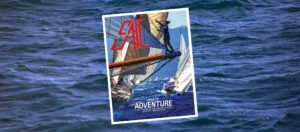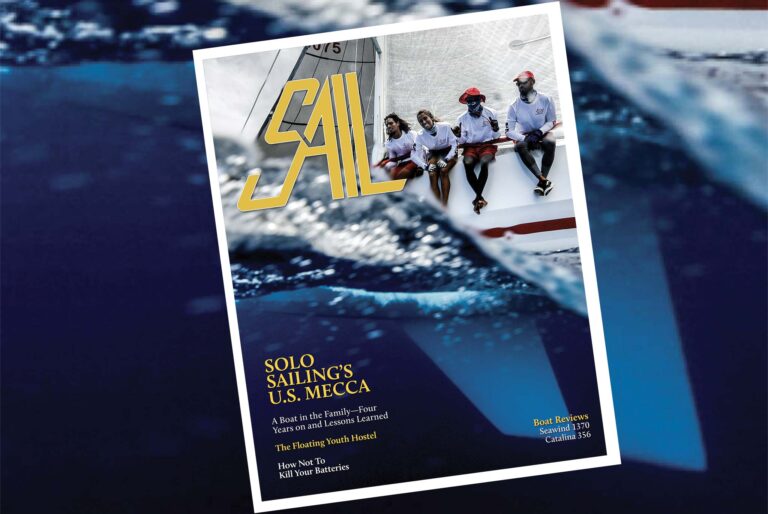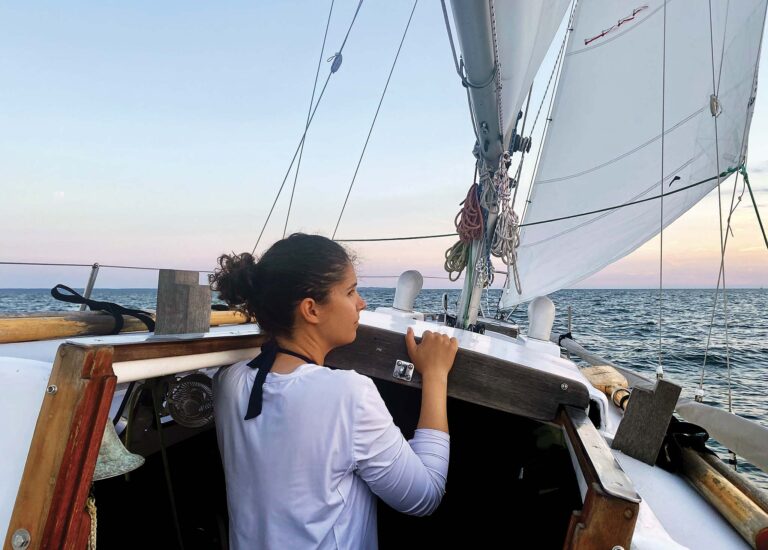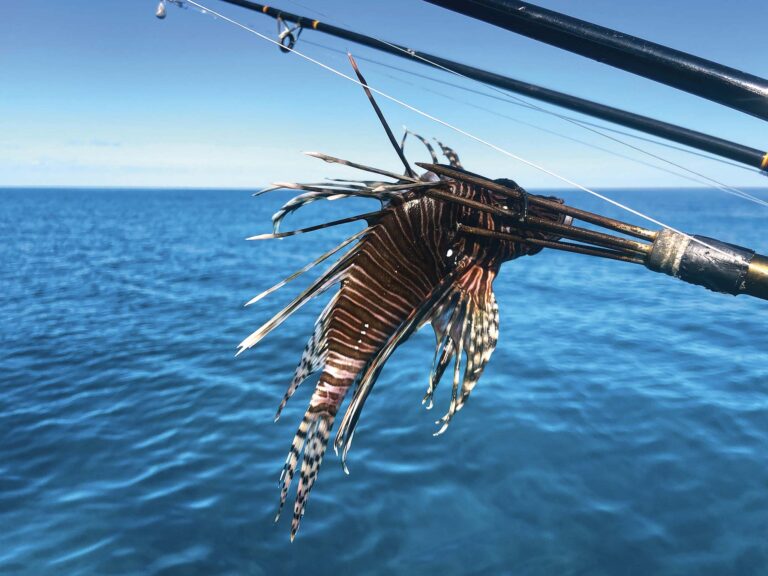
1: This is my plan, and behold, it is flexible
All successful coastal cruises start with a plan. The trouble is, most of us who have managed well enough in life’s battles to be able to own or charter a cruising sailboat have developed a tendency to feel goals must be achieved, regardless. This may be laudable when confronting a sales target or building a house, but it’s not necessarily a winning formula when taking the family for a holiday with limited time under the hovering axe ofthe weather.
One of the best tips I ever heard concerns those of us whose home port is on a stretch of coast with options in both directions: Plan two trips, one on either side. On the day, choose the downhill route with the fair wind.
Don’t imagine that the uphill choice will get the bad part out of the way first and guarantee you an easy ride home.Think about it; the logic’s flawed. Go for the soft option and enjoy the sailing. You might just get lucky and have a grand trip back as well. If you don’t, you’ll have to face the long beat, but at least there’s been some fair weather to look back on. Had you chosen the beat to start with, and then the wind went foul at turn-around time, you’d look pretty sick and the kids might not want to come next year.

2: Thou shalt not try to do too much
I belong to a well-known international cruising club. Our members manage some remarkable exploits, but when I scan the annual journal crammed with our logs, I sometimes lose the will to live. “We visited 25 harbors in 30 days,” doesn’t sound to me like a formula for a jolly time. Sure, we’re all out there to go sailing, but the life of a port is part of seafaring too. When I find a place I like, I’m well pleased if I have enough time to stay awhile—to sample the beaches, climb the local hills, hit that colorful bar on the waterfront, see what the museum can teach me and take time for a yarn with the guy on the next boat over. Missing out on all this is a big loss. It can be fun to head off to the horizon for a fortnight, but there’s always the danger of ending up like the enlisted man who “joined the navy to see the world, and what did I see? I saw the sea.”
3: Remember the ship’s log book, and keep it holy
Oddly enough, the log book is more important now that we know where we are than it ever was in the dark ages of pre-GPS nostalgia when most of us didn’t. Back then, we kept track of our position by plotting a series of dead-reckoning positions backed up by fixes, all neatly inscribed in soft pencil on the sacred paper chart. As long as we knew where we’d been—more or less—an hour ago, and we’d noted our course steered and distance run, we could work up a new DR any time.
Except for those who choose to maintain this discipline, this is no longer the case because most people now favor electronic chartplotters as their primary data source. Used properly, this is a better solution, but the key to safety—as well as asking the instrument the right questions and being educated regarding its shortcomings—is having a paper backup. A paper chart gives the sort of overview a plotter never can. Also, it is ready to take over if Uncle Sam decides to turn off the satellites or, more likely, some clown has a fun day out jamming the signals with a gizmo he bought on eBay for fifteen bucks.
None of this will matter a hoot to the sailor who has kept a paper log book. All he has to do when the lights go out is read off his last known position, plot it on the paper chart and extrapolate course steered and distance run. Happiness. No log book? Fear, loathing and misery.
Oh yes, and a good, creative log book is great fun to read in years to come when you recall that awful breakfast when the skipper served up chilli omelette and tipped in the whole packet of flakes.

4: The anchor is thy strength and salvation. Thou shalt have no priorities before it
Marinas are OK, but for really satisfying cruising, you must be able to anchor with confidence. The ground tackle that comes with production boats is usually a joke. Check out any long-term offshore boat, and you’ll see what I mean. Typically, manufacturers supply the absolute minimum that will secure the yacht over lunch on a nice day in good holding. It’s no use at all for a windy night on a rocky shore. My Mason 44 has a 65lb Bruce on the stemhead, 270 feet of ⅜in chain in the locker and a respectable electric windlass, so I don’t injure myself trying to heave it in. Much is written about anchors and anchoring, but the bottom line, as you might say, is always weight. Plenty of it. You can’t beat it, and lots of chain.
Because I have a good windlass, I’m not shy about using a scope so dragging is never an issue. I lay the pick carefully, dig it in as though I mean business, then pour myself a Scotch. I put up my riding light where it will burn brightly and be seen by everyone, and I sleep the slumber of the just. Nothing else will do. And if ever my engine should fail on a lee shore, salvation is waiting on the bow roller.
5: Remember to stow long ropes, because the day will surely come when nothing else will preserve the ship
It’s remarkable what a boat that sails from marinas all the time can get away with in terms of shorelines. They’re a bit like ground tackle, in that boatbuilders supply their wares with miserly lengths that just about reach the posts in a box berth. These “shorties” are useful because nobody wants to be coiling 90ft lengths when 20ft is more than enough. Keep the little docklines and be glad of them, but sooner or later you’ll need a couple of serious lines. A kedge warp can be pressed into service. Since this will be nylon, that’s all to the good. An extra one is well worth the money too. You may want to tow someone, or even be towed yourself. If it’s the latter, it’s far better not to take his rope, because that might make you liable for salvage. Politely heave him your own, then buy him a drink when you get in.
6: Thou shalt not bear false spares for the engine
I once bought a boat with a box full of impellers, filters and the like, only to discover when I needed them that my predecessor must have acquired them in a yard sale. None of them fitted. Any boat that’s cruising, even along the coast, simply must carry at least one spare engine cooling-pump impeller. A sound plan is to change this vital unit each season, then keep the old one that has not failed as backup. This reminds you of how to do the job, and it makes failure less likely because the new impeller is lovely and pliable. It also ensures that the spare actually fits.
I can’t imagine going cruising without at least two fuel filters in the locker, plus the certain knowledge that I can personally replace them and bleed the engine back to life. If you’ve never had to do this, wait for your first fill of dirty fuel and be happy that you carried the extras. They only need to be bought once, because, thereafter, the working element (or two if two are fitted), is changed each season while the spares stay tucked away awaiting their moment of glory.
7: Fill your ship’s food lockers with heavy staples. Sufficient unto the day are the luxuries thereof
It’s always a blast going round the stores in strange ports to see what delicacies and rare delights are on offer. Carrying a quart of clams back to the boat isn’t onerous. Nor is popping a couple of fresh loaves into the tote bag. What you don’t want when you’re far from home on a hot day is to end up humping 50lb of assorted potatoes, onions, rice and a few six-packs a mile or more down to the dinghy. Plan food shopping well ahead. Bring all heavy staples on board before you leave the home slip and while you still have a car.

8: Beware of Scribes bearing clipboards
In other words, keep the paperwork in order. It may not be important to carry ship’s registration documents and passports if a planned cruise is from New Hampshire to Maine and back, but if you are heading north from San Francisco toward Vancouver, you’ll need the lot. If you intend to cross an international border, ship everything you can think of: liferaft certificates, radio licenses, insurance, registration, tax-paid evidence perhaps, and so on.
9: Rejoice in well-tried shipmates and put no trust in strangers
The people we work with, drinking buddies and the like, do not necessarily make good shipmates. Family is generally fine unless there are underlying issues. If there are, a lively passage or two is a tested way of effecting resolution—one way or the other. Whoever you are sailing with, it makes life a lot easier if you stick with them for the duration.
Crew changes are a sure and certain source of stress. Sailing boats—even modern ones with powerful engines— are not at their best keeping to tight schedules. If Cousin Courtney has bought an air ticket to Snug Harbor and will be waiting on the dock next Friday, you can bet your last dollar the wind will be on the nose and nobody will want to make the passage. It happens every time. I could count the occasions on one hand where I’ve been waiting happily for my next crew in a port of my choice with the timing just right. Avoid crew changes if you can, make peace with teenage daughters, buy your partner a new suit of foulweather gear and have a nice trip.

10: Let maintenance be the watchword
Today’s sailboats should be as reliable as cars have become. Despite all efforts to depersonalize them, however, boats remain essentially organic products. The sea isn’t like the two-dimensional highway. It has waves, which when added to the wind, demand more than is ever asked of our refined automobiles. Diesel engines are integral to today’s cruising. Their reliability has come unimaginable distances since I first turned a marine starter key 50 years back. If a diesel fails in service, it is almost invariably due to poor servicing, or no servicing at all. Either we do it ourselves or we pay to have someone else do it, but attend to it we must because engine failures cause more call-outs for the emergency services than anything else.
It’s off most general service schedules, but do make sure fuel tanks are clean because this is where problems often lurk. Cleaning tanks aren’t easy. If you can’t face it, hire a professional, but get it done. You might be surprised at what comes out. The same goes for rig, winches and sails. Routine maintenance is well covered in this magazine. All I can do is stress its importance.
That said, perhaps the 11th commandment should be, “Don’t get bogged down worrying about what could go wrong. Do what you can, then get out there and enjoy yourself. Things are rarely as bad as they look!”
Tom Cunliffe sails his Mason 44 in the North Atlantic and Baltic. His new book, The Complete Ocean Skipper, is currently available
June 2016









